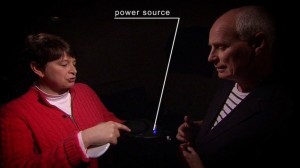Wireless Electricity? It’s Here
SCIENCE, 17 Mar 2014
Matthew Ponsford and Nick Glass - CNN
Katie Hall was shocked the second she saw it: a light-bulb glowing in middle of a room with no wires attached.
Looking back, it was a crude experiment, she remembers: a tiny room filled with gigantic cooper refrigerator coils — the kind you’d see if you cracked open the back of your freezer.
She walked in and out between the coils and the bulb — and still the bulb glowed.
“I said: ‘Let’s work on this. This is the future,'” Hall said.
What’s the trick?
“We’re going to transfer power without any kind of wires,” said Dr Hall, now Chief Technology Officer at WiTricity — a start-up developing wireless “resonance” technology.
“But, we’re not actually putting electricity in the air. What we’re doing is putting a magnetic field in the air.”
It works like this: WiTricity build a “Source Resonator” — a coil of electrical wire that generates a magnetic field when power is attached.
If another coil is brought close, an electrical charge can be generated in it. No wires required.
“When you bring a device into that magnetic field, it induces a current in the device, and by that you’re able to transfer power,” explains Dr Hall.
And like that, the bulb lights up.
Wireless homes
Don’t worry about getting zapped — Hall assures that the magnetic fields used to transfer energy are “perfectly safe” — in fact, they are the same kind of fields used in Wi-Fi routers.
In the house of the future, wire-free energy transfer could be as easy as wireless internet.
If all goes to WiTricity’s plans, smartphones will charge in your pocket as you wander around, televisions will flicker with no wires attached, and electric cars will refuel while sitting on the driveway.
WiTricity have already demonstrated their ability to power laptops, cell-phones, and TVs by attaching resonator coils to batteries — and an electric car refueller is reportedly in the works.
WiTricity opened an office in Nibley, Utah in 2013to help develop their wireless technology.
Hall sees a bright future for the family without wires.
“We just don’t think about it anymore: I’m going to drive my car home and I’m never going to have to go to the gas station and I’m never going to have to plug it in,” Hall said.
“I can’t even imagine how things will change when we live like that.”
World outside
Beyond these effort-saving applications, Hall sees more revolutionary steps.
When Hall first saw the wireless bulb, she immediately thought of medical technology — seeing that devices transplanted beneath the skin could be charged non-intrusively.
WiTricity is now working with a medical company to recharge a left-ventricular assist device — “a heart-pump essentially.”
The technology opens the door to any number of mobile electronic devices which have so far been held back by limited battery lives.
“The idea of eliminating cables would allow us to re-design things in ways that we haven’t yet thought of, that’s just going to make our devices and everything that we interact with, that much more efficient, more practical and maybe even give brand new functionality,” Hall said.
What’s next?
The challenge now is increasing the distance that power can be transferred efficiently. This distance — Hall explains — is linked to the size of the coil, and WiTricity wants to perfect the same long-distance transfers to today’s small-scale devices.
For this reason, the team have high hopes for their new creation: AA-sized wirelessly rechargeable batteries.
For Hall, the applications are endless.
“I always say kids will say: ‘Why is it called wireless?'” Hall said. “The kids that are growing up in a couple of years will never have to plug anything in again to charge it.”
The-CNN-Wire™ & © 2014 Cable News Network, Inc., a Time Warner Company. All rights reserved.
DISCLAIMER: The statements, views and opinions expressed in pieces republished here are solely those of the authors and do not necessarily represent those of TMS. In accordance with title 17 U.S.C. section 107, this material is distributed without profit to those who have expressed a prior interest in receiving the included information for research and educational purposes. TMS has no affiliation whatsoever with the originator of this article nor is TMS endorsed or sponsored by the originator. “GO TO ORIGINAL” links are provided as a convenience to our readers and allow for verification of authenticity. However, as originating pages are often updated by their originating host sites, the versions posted may not match the versions our readers view when clicking the “GO TO ORIGINAL” links. This site contains copyrighted material the use of which has not always been specifically authorized by the copyright owner. We are making such material available in our efforts to advance understanding of environmental, political, human rights, economic, democracy, scientific, and social justice issues, etc. We believe this constitutes a ‘fair use’ of any such copyrighted material as provided for in section 107 of the US Copyright Law. In accordance with Title 17 U.S.C. Section 107, the material on this site is distributed without profit to those who have expressed a prior interest in receiving the included information for research and educational purposes. For more information go to: http://www.law.cornell.edu/uscode/17/107.shtml. If you wish to use copyrighted material from this site for purposes of your own that go beyond ‘fair use’, you must obtain permission from the copyright owner.
